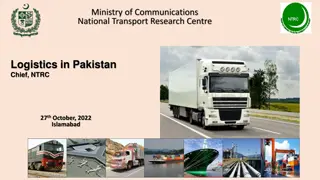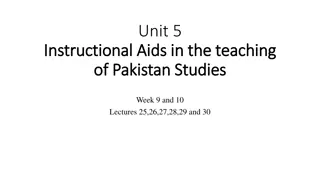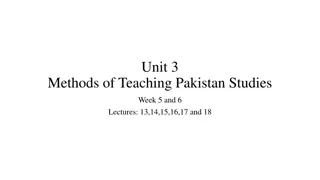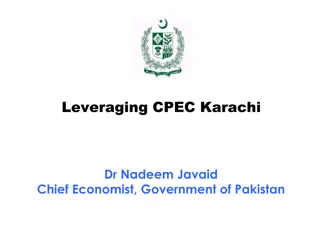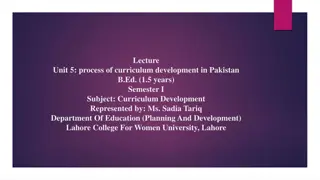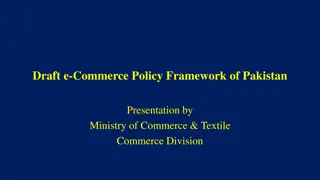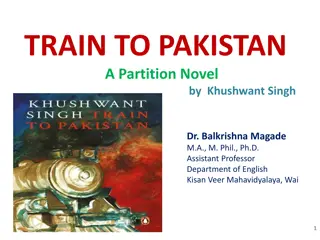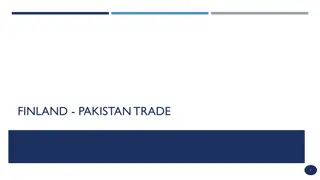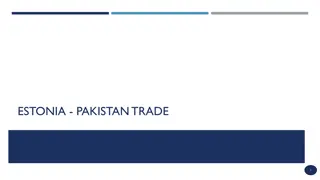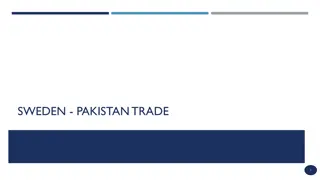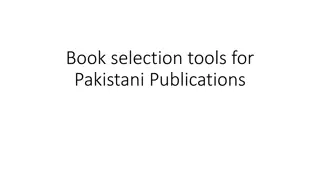Objectives and Aims of Teaching Pakistan Studies in Education
Understanding the objectives and aims of teaching Pakistan Studies is essential for educators. Objectives serve as guiding points in the teaching-learning process, providing a framework for evaluation and development. On the other hand, aims are broader and philosophical, focusing on the purpose and scope of education in Pakistan. By delineating clear aims and objectives, educators can effectively impart knowledge about the culture, society, and ideology of Pakistan to students, fostering critical thinking and social awareness.
Download Presentation

Please find below an Image/Link to download the presentation.
The content on the website is provided AS IS for your information and personal use only. It may not be sold, licensed, or shared on other websites without obtaining consent from the author. Download presentation by click this link. If you encounter any issues during the download, it is possible that the publisher has removed the file from their server.
E N D
Presentation Transcript
Methods of Teaching Pakistan Studies Maj/B.Eds-311 Ms. Nadia Saleem BS-III(2017-2021) Spring 2020
Unit 1 Objectives of teaching Pakistan studies Week 1 and 2 Lectures: 1,2,3,4,5 and 6
General Aims and Objectives of Pakistan Studies General Aims: In this unit general aims and objectives with references to Pakistan Studies have been briefly discussed. While going through these aims and objectives, one can clearly observe that 'Aims' are broad and philosophical in nature and scope while objectives are specific and more behavior oriented. Aims are concerned with purpose whereas objectives are concerned with achievement. Usually an educational objective relates to gaining an ability, a skill, some knowledge, a new attitude etc
CONT The objective on the other hand, is more specific and more functional as compared to the aims of a particular subject. They are specific ones which describe behavior to be attained in a particular unit, a subject, area, a course, or a grade level program. Statements that Pakistan should preserve the ideology of Pakistan, transmit culture, reconstruct society or provide for the fullest development of the individuals, are aims attributed to the subject. Moreover, similar statements like the development of the democratic way of life, creation of a to literate society, are aims which are general in nature and are insufficient guide for making a more specific decision about the development of certain program.
Statements of Aims Several statements of aims can to framed such as, a. The development of effective ways of thinking. b. The development of increased sensitivity to social problems and issues of Pakistan. c. The inculcation of social rather selfish attitude towards different people and communities in Pakistan. d. The development of appreciation of literature, art and music of the different regions of Pakistan. e. The increased personal- social adjustment into the rapidly changing conditions of life of Pakistani society.
Objectives of teaching Pakistan Studies Objectives play an important role in teaching-learning process. They are starting points. Nothing can be done without having any target to be achieved. Objectives serve as a guide for the evaluation of achievement. Objectives are developmental representing "roads to travel" rather than terminal points. Therefore, the teacher of teaching of Pakistan Studies should keep continuity in the formulation of objectives and appreciation of the developments taking place in social, cultural and geo- political environment of the country. The formulation of objectives in curriculum are in fact based on the collective value position which is supposed to be reflecting of Pakistan society.
Statements of Objectives Some examples of objectives of curriculum of Pakistan Studies at secondary level are given below. a. To understand the concept of sovereignty of Allah in Islam. b. To know the advent of Islam in the sub-continent. c. To create feeling of pride for the rich heritage of Islam. d. To develop appreciation for the salient feat.. of Muslim life. e. To enable the students to participate in debates, dramas and other activities.
Objective of teaching of Pakistan studies: The Pakistan Studies was introduced as a compulsory subject in classes IX-X in 1960. The main purpose of the course having to promote the knowledge of the individual about himself, the country and the world around him, significance of nation building problems, development of social and moral consciousness that should lead to healthy living in egalitarian society. A wide variety of objectives of teaching of Pakistan studies have been framed which is hoped to reflect the true spirit of the course. These objectives are:
CONT a. The teaching of Pakistan Studies would help learners to come to a greater awareness of themselves, to classify and examine their values and to establish a sense of self identify as a true Pakistani. b. It would provide learners with an understanding of past events and persons and of their roles is shaping their lives and destiny. c. It would promote in learners a concern for the development of an understanding and acceptance of others in different regions of the country.
CONT d. It would provide learners with a knowledge of human systems in the areas of economics, government and culture. e. It would provide learners with the skill necessary to carryout independent investigation of problems and to react critically to the solution posed by others. f. It would provide learners with an awareness of possible features and the roles they might play in shaping those feature. g. It would provide learners with an appreciation of peoples 'efforts to improve humor conditions, through creative expression and problems solving.
CONT h. It would provide learners with an understanding of decision making process involved in human interaction and with the skill necessary to become effective decision maker. I. It would provide learners with the ability to utilize both cooperative and competence circumstances for the achievement of goals. J. It would provide learners with a sensitivity towards their own potential and their fellow human beings.
Classification of Objectives Blooms Taxonomy The taxonomy of educational objectives is comprised of six levels, namely: 1. knowledge, 2. comprehension, 3. application, 4. analysis, 5. synthesis, and 6. evaluation.
Cognitive Domain Knowledge refers to the recall of previously learned material. Students are required to remember facts, principles, steps in a sequence, and other information in the same way in which the material was presented in class. Keywords: Arrange, define, describe, match, order, memorize, name, note, repeat, questions (Who? What? When? Where?). The key activity is to recall, memorizing information, defining techniques.
CONT Comprehension refers to the understanding of learned material. Students must show that they grasp the meaning of the material by explaining, interpreting, translating to a new form or symbol system, and extrapolating. Keywords: Alter, change, classify, define in your own words, discuss, explain, extend, give examples, translate. The key activity is to explain. Understanding an article with the objective of providing a summary.
CONT Application refers to the ability to use learned material in new and concrete situations. Students must use abstractions, such as concepts, principles, rules, theories, and laws to find solution to new problems. Keywords: Apply, calculate, compute, construct, operate, practice, write an example question (how many? Which? What is?). The key activity is to transfer.
CONT Analysis refers to the ability to break down material into its component parts so that the organizational structure is understood. Students are required to determine distinguishing characteristics, show the relationship between parts, and so on. Keywords: Analyse, appraise, categorise, compare, conclude, contrast, criticize, diagnose, differentiate, etc. The key activity is to separate.
CONT Synthesis refers to the ability to put parts together to form a new whole that was not previously present. Students must think creatively to produce new products, such as a theme, speech, article, or research proposal. Keywords: Assemble, compile, compose, create, improve, synthesize, what if, etc. Questions (How can we improve? What would happen if? How can we solve?). The key activity is to combine. Note that multiple-choice test formats are not good for testing synthesis.
CONT Evaluation refers to the ability to judge the value of material for a given purpose using definite criteria. Students are required to make value judgments, to create ideas or objects, and to accept or reject materials based on standards. Keywords: Appraise, argue, choose, certify, criticize, decide, deduce, defend, discriminate, estimate, evaluate, recommend, etc. The key activity is to judge. Judging the value of a subject for a specific purpose
Affective Domain It deals with attitudes, liking, disliking, habits, values and feelings. It is further divided in to five levels, namely: 1. Receiving 2. Responding 3. Valuing 4. Organizing 5. Characterization
CONT Receiving Phenomena: Awareness, willingness to hear, selected attention. Key Words: acknowledge, asks, attentive, courteous, dutiful, follows, gives, listens, understands Examples: Listen to others with respect. Listen for and remember the name of newly introduced people.
CONT Responds to Phenomena: Active participation on the part of the learners. Attend and react to a particular phenomenon. Learning outcomes may emphasize compliance in responding, willingness to respond, or satisfaction in responding (motivation). Key Words: answers, assists, aids, complies, conforms, discusses, greets, helps, labels, performs, presents, tells Examples: Participates in class discussions. Gives a presentation. Questions new ideals, concepts, models, etc. in order to fully understand them. Know the safety rules and practice them.
CONT Valuing: The worth or value a person attaches to a particular object, phenomenon, or behavior. This ranges from simple acceptance to the more complex state of commitment. Valuing is based on the internalization of a set of specified values, while clues to these values are expressed in the learner's overt behavior and are often identifiable. Key Words: appreciates, cherish, treasure, demonstrates, initiates, invites, joins, justifies, proposes, respect, shares Examples: Demonstrates belief in the democratic process. Is sensitive towards individual and cultural differences (value diversity). Shows the ability to solve problems. Proposes a plan to social improvement and follows through with commitment. Informs management on matters that one feels strongly about.
CONT Organization: Organizes values into priorities by contrasting different values, resolving conflicts between them, and creating an unique value system. The emphasis is on comparing, relating, and synthesizing values. Key Words: compares, relates, synthesizes Examples: Recognizes the need for balance between freedom and responsible behavior. Explains the role of systematic planning in solving problems. Accepts professional ethical standards. Creates a life plan in harmony with abilities, interests, and beliefs. Prioritizes time effectively to meet the needs of the organization, family, and self.
CONT Characterization: Has a value system that controls their behavior. The behavior is pervasive, consistent, predictable, and most important characteristic of the learner. Instructional objectives are concerned with the student's general patterns of adjustment (personal, social, emotional). Key Words: acts, discriminates, displays, influences, modifies, performs, qualifies, questions, revises, serves, solves, verifies Examples: Shows self-reliance when working independently. Cooperates in group activities (displays teamwork). Uses an objective approach in problem solving. Displays a professional commitment to ethical practice on a daily basis. Revises judgments and changes behavior in light of new evidence. Values people for what they are, not how they look.
Psychomotor Domain It deals with the development of psychomotor skills. It is further divided in to seven subgroups by Simpson in 1972: 1. Perception 2. Set 3. Guided Response 4. Mechanism 5. Complex Overt Response 6. Adaptation 7. Origination
CONT Perception (awareness): The ability to use sensory cues to guide motor activity. This ranges from sensory stimulation, through cue selection, to translation. Examples: Detects non-verbal communication cues. Estimate where a ball will land after it is thrown and then moving to the correct location to catch the ball. Adjusts heat of stove to correct temperature by smell and taste of food. Adjusts the height of the forks on a forklift by comparing where the forks are in relation to the pallet. Key Words: chooses, describes, detects, differentiates, distinguishes, identifies, isolates, relates, selects.
CONT Set: Readiness to act. It includes mental, physical, and emotional sets. These three sets are dispositions that predetermine a person's response to different situations (sometimes called mindsets). Examples: Knows and acts upon a sequence of steps in a manufacturing process. Recognize one's abilities and limitations. Shows desire to learn a new process (motivation). NOTE: This subdivision of Psychomotor is closely related with the Responding to phenomena subdivision of the Affective domain. Key Words: begins, displays, explains, moves, proceeds, reacts, shows, states, volunteers.
CONT Guided Response: The early stages in learning a complex skill that includes imitation and trial and error. Adequacy of performance is achieved by practicing. Examples: Performs a mathematical equation as demonstrated. Follows instructions to build a model. Responds hand-signals of instructor while learning to operate a forklift. Key Words: copies, traces, follows, react, reproduce, responds.
CONT Mechanism (basic proficiency): This is the intermediate stage in learning a complex skill. Learned responses have become habitual and the movements can be performed with some confidence and proficiency. Examples: Use a personal computer. Repair a leaking faucet. Drive a car. Key Words: assembles, calibrates, constructs, dismantles, displays, fastens, fixes, grinds, heats, manipulates, measures, mends, mixes, organizes, sketches.
CONT Complex Overt Response (Expert): The skillful performance of motor acts that involve complex movement patterns. Proficiency is indicated by a quick, accurate, and highly coordinated performance, requiring a minimum of energy. This category includes performing without hesitation, and automatic performance. For example, players are often utter sounds of satisfaction or expletives as soon as they hit a tennis ball or throw a football, because they can tell by the feel of the act what the result will produce. Examples: Maneuvers a car into a tight parallel parking spot. Operates a computer quickly and accurately. Displays competence while playing the piano. Key Words: assembles, builds, calibrates, constructs, dismantles, displays, fastens, fixes, grinds, heats, manipulates, measures, mends, mixes, organizes, sketches. NOTE: The Key Words are the same as Mechanism, but will have adverbs or adjectives that indicate that the performance is quicker, better, more accurate, etc.
CONT Adaptation: Skills are well developed and the individual can modify movement patterns to fit special requirements. Examples: Responds effectively to unexpected experiences. Modifies instruction to meet the needs of the learners. Perform a task with a machine that it was not originally intended to do (machine is not damaged and there is no danger in performing the new task). Key Words: adapts, alters, changes, rearranges, reorganizes, revises, varies.
CONT Origination: Creating new movement patterns to fit a particular situation or specific problem. Learning outcomes emphasize creativity based upon highly developed skills. Key Words: arranges, builds, combines, composes, constructs, creates, designs, initiate, makes, originates Examples: Constructs a new theory. Develops a new and comprehensive training programming. Creates a new gymnastic routine.
OBJECTIVE OF TEACHING OF PAKISTAN STUDIES AT SECONDARY LEVEL Large number of objectives of teaching of Pakistan Studies have been formulated in behavioral terms, covering nine chapters of the prescribed course. The most significant have been selected and are stated below: Cognitive: 1. To understand the concept of sovereignty of Allah, the cardinal points of Islamic way of life and the advent of Islam in the subcontinent. 2. To know about the changing socio political conditions of the subcontinent.
CONT 3. To know about the significant events at the time of creation and consequences of partition of Muslim majority provinces. 4. To know about the guiding principles and elements of constitutional history of Pakistan. 5. To get acquainted with the geographical and strategically location and other physical features and climate of Pakistan. 6. To have knowledge about the type of soil, forests, minerals and agriculture of Pakistan. 7. To get acquainted with agricultural reforms and their objectives.
CONT 8. To get acquainted with the importance of natural resources and communication system. 9. To get understand with in characteristics of people of Pakistan their demographic features and the process of urban development in Pakistan. 10.To get acquainted with the importance of regional languages as a sign of national unity. 11.To get acquainted with the structure and state of education in Pakistan.
CONT 12.To understand the purposes and functions of UNO and get acquainted with the support of member countries extended to Pakistan. 13.To get acquainted with the Muslim countries, their human and material resources and the role played by Pakistan for the unity of Muslim world. 14.To know about independent foreign policy of Pakistan. 15.To know about the concept of welfare Stale and the ways and means to make Pakistan a welfare State?
Affective The affective aspect of the objectives of teaching of Pakistan Studies centers round the following. 1. Feeding of pride for the rich heritage of Pakistan and appreciation for the salient features of Muslim life. 2. Appreciation for the sacrifices rendered by the Muslims, who migrated at the time of partition. 3. Feelings for orderly government, appreciation for cooperation and urge for the upholding the constitution.
CONT Appreciation and respect for landscapes and those who toil under hard climatic conditions. Appreciation for the dignity of labour. Thankfulness to Almighty Allah for natural resources. Urge for equitable distribution of basic necessities of life. Appreciation for the national cultural heritage.
CONT Appreciation for necessity of education and urge for functional education. Appreciation for the service of mankind. Love for Islamic values and appreciation for Muslim unity. Appreciation for human values and love for mankind.
Psychomotor Psychomotor: The psychomotor objectives relate to: Make maps, charts and diagram. Make speeches and participate in debates. Visit Provincial and National Assembly session. Take part in role playing. Make models.
CONT Visit agricultural farms and river sites. Collect .formation data through various sources. Participate in seminar and group discussions. Organize exhibition of handicrafts. Visit local educational institutions.
CONT Collect flags, stamps and view cards. Prepare albums, collecting pictures coins and flags of Muslim countries. Participate in National Volunteer Services.






